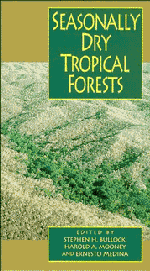Book contents
- Frontmatter
- Contents
- List of contributors
- Acknowledgements
- 1 Introduction
- 2 Dry forests of Central America and the Caribbean
- 3 Overview of the Brazilian caatinga
- 4 Savannas, woodlands and dry forests in Africa
- 5 Dry forest ecosystems of Thailand
- 6 The Cenozoic record of tropical dry forest in northern Latin America and the southern United States
- 7 Diversity and floristic composition of neotropical dry forests
- 8 Vertebrate diversity, ecology and conservation in neotropical dry forests
- 9 Diversity of life forms of higher plants in neotropical dry forests
- 10 Drought responses of neotropical dry forest trees
- 11 Plant reproduction in neotropical dry forests
- 12 Plant–herbivore interactions in Mesoamerican tropical dry forests
- 13 Biomass distribution and primary productivity of tropical dry forests
- 14 Nutrient cycling in tropical deciduous forests
- 15 Biology of the belowground system of tropical dry forests
- 16 Nitrogen trace gas emissions in a tropical dry forest ecosystem
- 17 Conversion of tropical dry forest to pasture and agriculture
- 18 Ethnobotany of the Mexican tropical dry forests
- Index
17 - Conversion of tropical dry forest to pasture and agriculture
Published online by Cambridge University Press: 07 September 2010
- Frontmatter
- Contents
- List of contributors
- Acknowledgements
- 1 Introduction
- 2 Dry forests of Central America and the Caribbean
- 3 Overview of the Brazilian caatinga
- 4 Savannas, woodlands and dry forests in Africa
- 5 Dry forest ecosystems of Thailand
- 6 The Cenozoic record of tropical dry forest in northern Latin America and the southern United States
- 7 Diversity and floristic composition of neotropical dry forests
- 8 Vertebrate diversity, ecology and conservation in neotropical dry forests
- 9 Diversity of life forms of higher plants in neotropical dry forests
- 10 Drought responses of neotropical dry forest trees
- 11 Plant reproduction in neotropical dry forests
- 12 Plant–herbivore interactions in Mesoamerican tropical dry forests
- 13 Biomass distribution and primary productivity of tropical dry forests
- 14 Nutrient cycling in tropical deciduous forests
- 15 Biology of the belowground system of tropical dry forests
- 16 Nitrogen trace gas emissions in a tropical dry forest ecosystem
- 17 Conversion of tropical dry forest to pasture and agriculture
- 18 Ethnobotany of the Mexican tropical dry forests
- Index
Summary
Introduction
Conversion of tropical dry forest to agriculture and pasture is occurring at alarming rates, and entails nearly total destruction of forest structure and composition, and disruption of ecosystem functions. In this chapter the driving forces of this process are briefly discussed, the general pattern of the transformation is described, and the consequences of the conversion for ecosystem functioning are analysed in some detail. Particular attention is given to specific environmental conditions and management practices that determine or alter the extent of the perturbation.
Causes and patterns of forest conversion
Driving forces
Janzen (1986) considers dry forest as the ‘most endangered major tropical ecosystem’ because the distribution of these forests has been reduced to a small fraction of the original area. Less than 0.1% of the original dry forest has conservation status in Pacific Mesoamerica. The status of dry forest is just as critical, or worse, for regions of Australia, Southeast Asia, Africa, and major parts of South America (Janzen, 1986, 1988). Actual rates and the extent of dry forest conversion are analysed by Murphy & Lugo (Chapter 2). They have pointed out that we will never know the true original or potential extent of dry forest because many savannas and scrub or thorn woodlands are thought to be derived from disturbed dry forest (Murphy & Lugo, 1986; see Menaut, Lepage & Abbadie, Chapter 4).
There are ecological, social, political and economic factors involved in forest clearing for agricultural purposes. Often subsistence farmers are blamed for the massive deforestation in the tropics, but other groups are also involved in this process. According to Thapa & Weber (1990), those responsible for deforestation can be broadly categorized into three main groups.
- Type
- Chapter
- Information
- Seasonally Dry Tropical Forests , pp. 399 - 422Publisher: Cambridge University PressPrint publication year: 1995
- 70
- Cited by



